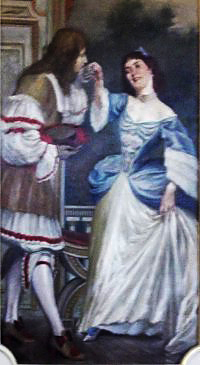Minuet from Don Giovanni

Fresco at Municipal Theatre of Rio de Janeiro
Don Giovanni is the character better known as Don Juan, the suitor, the lady-killer. Mozart composed an opera about him, though, in the opera, everything goes wrong for him.
But, anyway: in the ending of the first act of the opera, Don Giovanni invites all characters to a great ball at his palace, where he intends to secretly seduce some young ladies, among them a peasant called Zerlina, engaged to Masetto, also a peasant. Then, he waves at the orchestra and the musicians start playing a minuet:
[audio:http://euterpe.blog.br/wp-content/uploads/2012/01/menueto.mp3|titles=Mozart: Don Giovanni K.527 – Minuet]In 3/4 time, the minuet was considered an aristocratic dance, thus it works well as a background to the noble and pompous side of the opera.
At certain point, Don Giovanni speaks to his servant, Leporello, and waves at two other musicians on the stage, who start tuning their instruments:
[audio:http://euterpe.blog.br/wp-content/uploads/2012/01/afinando-contradanca.mp3|titles=Mozart: Don Giovanni K.527 – Tuning]While Leporello distracts Masetto, Don Giovanni picks Zerlina for a contra dance:
[audio:http://euterpe.blog.br/wp-content/uploads/2012/01/contradanca.mp3|titles=Mozart: Don Giovanni K.527 – Contra dance]In binary rhythm (2/4), the contra dance is originally a British dance and, at the time Mozart lived, it was popular among the aristocracy as well as the common people. Quite suitable for a nobleman, such as Don Giovanni, dancing with a peasant, such as Zerlina.
In order to persuade Masetto to dance, Leporello waves at two other musicians on the stage and they also tune their instruments:
[audio:http://euterpe.blog.br/wp-content/uploads/2012/01/afinando-dancaalema.mp3|titles=Mozart: Don Giovanni K.527 – Tuning]Once the tuning is over, Leporello grabs Masetto and they dance a german dance:
[audio:http://euterpe.blog.br/wp-content/uploads/2012/01/dancaalema.mp3|titles=Mozart: Don Giovanni K.527 – German Dance]With a quick pace (3/8), the german dance was typical of the lower rank people and demanded greater physical contact between the couple, i.e., just perfect for the two comic characters of the opera.
Unfortunately, the dance ends up halfway because Zerlina screams from some room of the palace: she’s being attacked by Don Giovanni. Gosh, I guess I forgot to mention the most important: the three dances occur at the same time (so do the tunings):
[audio:http://euterpe.blog.br/wp-content/uploads/2012/01/completo.mp3|titles=Mozart: Don Giovanni K.527 – Complete Minuet]For better comprehension, on the excerpt above, I placed the minuet at the center, the contra dance on the right and the german dance on the left: listen using both speakers of the computer! Alternatively, you can watch the ball scene below:
http://www.youtube.com/watch?v=z88k8eoa6Tg
Mozart with polyrhythm? That’s it!
Text by Amancio Cueto Jr, translation by Tiago Arruda. For the original version in Portuguese, please click here.

 Welcome to Euterpe, a classical music blog!
Welcome to Euterpe, a classical music blog!